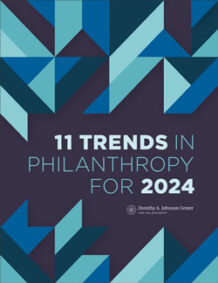Influencer Philanthropy Is On the Rise, but the Platform Matters


 This article was first published in our 11 Trends in Philanthropy for 2024 report. Explore the full report here.
This article was first published in our 11 Trends in Philanthropy for 2024 report. Explore the full report here.
Want the latest trends, research, and more delivered right to your inbox? Subscribe to the Johnson Center email newsletter !
The word “influencer” first began to register on Google Trends in mid-2015. Today, influencers are everywhere. The State of Influencer Marketing 2023: Benchmark Report from Influencer Marketing Hub predicted the total value of influencer marketing worldwide would hit $21.1 billion in 2023 — up from $1.7 billion in 2016 (Geyser). For younger generations, who either grew up with social media or were very young when these platforms first appeared in the early 2000s, being influenced by social media has become the norm. As Jamie Drummond and Roxane Philson (2015) stated, “Teens recognize YouTube stars more than Oscar winners” (para. 14) — and those parasocial bonds only continue to grow.
Philanthropy is at a critical moment for examining the bonds and traditions that influence (even teach) younger generations to give. According to an analysis of 2022 Giving USA data by Axios, “Americans gave 1.7% of their personal disposable income to charity in 2022, the lowest level they had given since 1995” (Saric, 2023, para. 4). Additionally, 30% of Americans now qualify in the “none” category of religious affiliation — meaning they self-identify as atheist, agnostic, or of no particular religion (Smith, 2023). The prevalence of traditional venues for sharing and modeling philanthropic values is shrinking, leaving us to ask what might take their place — and whether one answer might be social media.
Classy’s Why America Gives (2022) report demonstrates that next-gen donors (defined as millennials and Gen Z) are four times as likely as traditional donors (baby boomers and Gen X) to learn about a cause through influencers or celebrities, and that “69% of next-gen donors prefer to hear from organizations on social media, particularly on YouTube, Facebook, and Instagram” (p. 20).
The presence, efficacy, and scale of influencer philanthropy have been growing over the past decade or so. Brandon Stanton started Humans of New York on Facebook in 2010. His intimate images and interviews with everyday New Yorkers quickly earned him millions of followers. In 2013, Stanton became one of the earliest internet influencers to leverage social media for philanthropy in a trend-shifting way, raising over $100,000 from his community of followers for the Bedford-Stuyvesant YMCA (Quinn, 2015). In 2015, his campaign, Let’s Send Kids to Harvard, galvanized more than 50,000 donors from 108 countries, raising nearly $1.4 million and setting a record on IndieGoGo for total contributors (2015).
“Those familiar with the telethon fundraising events of the 1990s and earlier may recognize a similar, updated approach in the concept of the ‘charity stream’ — live, multi-hour fundraising events that reach viewers and donors not on TV but over social media.”
With the advent of newer social media platforms like TikTok and Twitch, the opportunities for influencers to leverage their followers for causes they believe in, or publicize their own philanthropy, have only expanded. Those familiar with the telethon fundraising events of the 1990s and earlier may recognize a similar, updated approach in the concept of the “charity stream” — live, multi-hour fundraising events that reach viewers and donors not on TV but over social media.
TikTok’s Mercury Stardust, a.k.a. the Trans Handy Ma’am, hosted the second annual TikTok-A-Thon for Trans Healthcare in March 2023, initiating a 24-hour livestream event that raised $2.2 million. The inaugural event in 2022 raised $120,000 in the same 24-hour period (DiBenedetto, 2023), demonstrating how quickly charity streams are growing in appeal and familiarity.
Yet the very nature of influencer philanthropy can be morally ambiguous. MrBeast, the most popular YouTuber in the world, has garnered hundreds of millions of views and followers through his extremely public acts of philanthropy — all captured on video, meticulously edited, and widely marketed. As Matthew Wade of La Trobe University points out,
Under this model of philanthropy, secrecy and discretion are simply not an option. Instead, to be maximally effective, MrBeast-style philanthropy must be a noisy spectacle — one that attracts massive audiences, brand deals, and merchandise sales, all of which can then be funneled into the next grand philanthropic gesture. … [I]t is obliged to be magnificent to sustain this perpetual engine of attention-driven philanthropy (2023, para 24).
Many nonprofits are taking the initiative to engage or even hire influencers to stream for their cause. According to M+R’s Benchmarks 2023 report,
Nearly half (47%) of nonprofits who answered our questions about social media influencers reported working with them in 2022 — but just 13% paid those influencers to post. …The most common use for influencer partnerships was content creation around narrative, persuasion, and/or culture change — 82% of nonprofits who partnered with paid influencers reported this type of effort. (paras. 57–58)
St. Jude’s Children’s Hospital stands out as an example of a nonprofit reaping huge benefits from influencer philanthropy and charity streams. St. Jude PLAY LIVE launched in 2012 (Asarch, 2019). Partnerships with Twitch, individual streamers, GuardianCon (now the Gaming Community Expo, a gaming convention committed to fundraising for St. Jude’s [GCX, 2019]), and anytime charity streams have helped St. Jude PLAY LIVE raise over $50 million (St. Jude PLAY LIVE).
Influencer-driven philanthropy is also leading to the creation of entirely new organizations. Aidan Kohn-Murphy started Gen Z for Change by activating other social media influencers around the 2020 election. The group now leverages around 500 content creators with a collective following of nearly half a billion people to respond to real-time calls to action (Mercado, 2023).
While influencer philanthropy is, by nature, driven by the appeal of its creator, the platform’s own functionality and popularity matter as well. Facebook’s Birthday Fundraisers raised more than $300 million in the 12 months following their 2017 launch (Banis, 2018). Today, Facebook’s role as a fundraising behemoth appears to be trending downward; M+R reported (2023) that overall revenue from Facebook (via any donation function) declined among survey respondents by 34% from 2021 to 2022. The average fundraising event in this sample garnered just four donations.
While Twitch and TikTok engage millions of users and donors, newer platforms like Mastodon may also benefit in the future by matching open-source structures with Gen Z’s preference for decentralized causes and flatter organizations and movements (Mercado, 2023), though it’s difficult to say precisely how user creativity may leverage this feature for philanthropy.
Fundraisers looking to establish long-term strategies for online giving may be best advised to focus on more predictable vehicles. Dedicated crowdfunding platforms like JustGiving (established in 2000) and GoFundMe (established in 2010) seem to have greater staying power when it comes to popularity among online givers: GoFundMe has helped individuals and organizations raise more than $25 billion in donations from more than 100 million people (2023).
Social media and its influencers will continue to play an increasingly visible and influential role in engaging and shaping young donors. Charitable organizations and communities will need to play a similarly important role in shaping how those lessons are sustained.


Asarch, S. (2019, July 9). How YouTubers and streamers are changing the face of charity. Newsweek. https://www.newsweek.com/youtube-charity-live-stream-twitch-st-jude-1448385
Banis, D. (2018, October 29). The problem with Facebook birthday fundraisers. Forbes. https://www.forbes.com/sites/davidebanis/2018/10/29/the-problem-with-facebook-birthday-fundraisers/
Classy. (2022). Why America Gives 2022: Finding resilience through donor loyalty. https://www.classy.org/why-america-gives/
DiBenedetto, C. (2023, March 31). TikTokkers, led by Mercury Stardust, double $1 million livestream goal for trans healthcare. Mashable. https://mashable.com/article/tiktok-transgender-healthcare-fundraiser-mercury-stardust
Drummond, J., & Philson, R. (2015, March 12). Communicating creatively: How to give voice to public support—seven lessons from ONE Campaign. Stanford Social Innovation Review. https://doi.org/10.48558/8G1E-8Y84
GCX. (2019, July 9). Press release. https://gcxevent.com/gcx-event-announcement/
Geyser, W. (2023, October 30). The State of Influencer Marketing 2023: Benchmark report. Influencer Marketing Hub. https://influencermarketinghub.com/influencer-marketing-benchmark-report/
GoFundMe. (2023). About us. https://www.gofundme.com/c/about-us
Google Trends. (2023). Influencer. https://trends.google.com/trends/explore?date=all&geo=US&q=influencer&hl=en
IndieGoGo. (2015, February 10). “Let’s Send Kids to Harvard” sets the record for biggest Indiegogo fundraiser. https://go.indiegogo.com/blog/2015/02/lets-send-kids-harvard-sets-record-biggest-indiegogo-fundraiser.html
M+R. (2023). Benchmarks 2023. https://mrbenchmarks.com/
Mercado, S. (2023, June 21). Gen Z paves the way for intergenerational philanthropy. Philanthropy News Digest. Candid. https://philanthropynewsdigest.org/news/exclusives/gen-z-paves-the-way-for-intergenerational-philanthropy
Quinn, M. (2015, March 1). Humans of New York: 5 HONY stories that raised over $1 million. GOBankingRates. https://www.gobankingrates.com/money/jobs/humans-new-york5-hony-stories-raised-over-1-million/
Saric, I. (2023, June 22). Americans are giving to charity at lowest level in nearly 3 decades. Axios. https://www.axios.com/2023/06/22/charitable-giving-donations-income
Smith, P. (2023, October 5). America’s nonreligious are a growing, diverse phenomenon. They really don’t like organized religion. Associated Press. https://projects.apnews.com/features/2023/the-nones/the-nones-us.html
St. Jude PLAY LIVE. (2023). https://www.stjude.org/get-involved/other-ways/video-game-charity-event.html
Wade, M. (2023, June 21). Kindness for clicks: MrBeast and the problem of philanthropy as spectacle. The ABC: Religion and Ethics. https://www.abc.net.au/religion/mrbeast-and-the-problem-of-philanthropy-as-spectacle/101998574